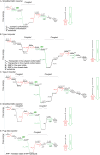Thermodynamics of ABC transporters
- PMID: 26408021
- PMCID: PMC4707154
- DOI: 10.1007/s13238-015-0211-z
Thermodynamics of ABC transporters
Abstract
ABC transporters form the largest of all transporter families, and their structural study has made tremendous progress over recent years. However, despite such advances, the precise mechanisms that determine the energy-coupling between ATP hydrolysis and the conformational changes following substrate binding remain to be elucidated. Here, we present our thermodynamic analysis for both ABC importers and exporters, and introduce the two new concepts of differential-binding energy and elastic conformational energy into the discussion. We hope that the structural analysis of ABC transporters will henceforth take thermodynamic aspects of transport mechanisms into account as well.
Keywords: ABC transporters; differential-binding energy; elastic conformational energy; energy-coupling.
Figures


Similar articles
-
ABC transporters, mechanisms and biology: an overview.Essays Biochem. 2011 Sep 7;50(1):1-17. doi: 10.1042/bse0500001. Essays Biochem. 2011. PMID: 21967049 Review.
-
Catalytic and transport cycles of ABC exporters.Essays Biochem. 2011 Sep 7;50(1):63-83. doi: 10.1042/bse0500063. Essays Biochem. 2011. PMID: 21967052 Review.
-
Mechanism of ABC transporters: a molecular dynamics simulation of a well characterized nucleotide-binding subunit.Proc Natl Acad Sci U S A. 2002 Oct 1;99(20):12639-44. doi: 10.1073/pnas.152439599. Epub 2002 Sep 17. Proc Natl Acad Sci U S A. 2002. PMID: 12237398 Free PMC article.
-
Structure and mechanism of ABC transporter proteins.Curr Opin Struct Biol. 2007 Aug;17(4):412-8. doi: 10.1016/j.sbi.2007.07.003. Epub 2007 Aug 27. Curr Opin Struct Biol. 2007. PMID: 17723295 Review.
-
Structural basis for the mechanism of ABC transporters.Biochem Soc Trans. 2015 Oct;43(5):889-93. doi: 10.1042/BST20150047. Biochem Soc Trans. 2015. PMID: 26517899 Review.
Cited by
-
Insect ATP-Binding Cassette (ABC) Transporters: Roles in Xenobiotic Detoxification and Bt Insecticidal Activity.Int J Mol Sci. 2019 Jun 10;20(11):2829. doi: 10.3390/ijms20112829. Int J Mol Sci. 2019. PMID: 31185645 Free PMC article. Review.
-
Towards Identification of the Substrates of ATP-Binding Cassette Transporters.Plant Physiol. 2018 Sep;178(1):18-39. doi: 10.1104/pp.18.00325. Epub 2018 Jul 9. Plant Physiol. 2018. PMID: 29987003 Free PMC article. Review.
-
Dibutyl phthalate alters the metabolic pathways of microbes in black soils.Sci Rep. 2018 Feb 8;8(1):2605. doi: 10.1038/s41598-018-21030-8. Sci Rep. 2018. PMID: 29422490 Free PMC article.
-
Thermodynamic secrets of multidrug resistance: A new take on transport mechanisms of secondary active antiporters.Protein Sci. 2018 Mar;27(3):595-613. doi: 10.1002/pro.3355. Epub 2017 Dec 15. Protein Sci. 2018. PMID: 29193407 Free PMC article. Review.
-
The Interplay of ABC Transporters in Aβ Translocation and Cholesterol Metabolism: Implicating Their Roles in Alzheimer's Disease.Mol Neurobiol. 2021 Apr;58(4):1564-1582. doi: 10.1007/s12035-020-02211-x. Epub 2020 Nov 19. Mol Neurobiol. 2021. PMID: 33215389 Review.
References
Publication types
MeSH terms
Substances
LinkOut - more resources
Full Text Sources
Other Literature Sources

